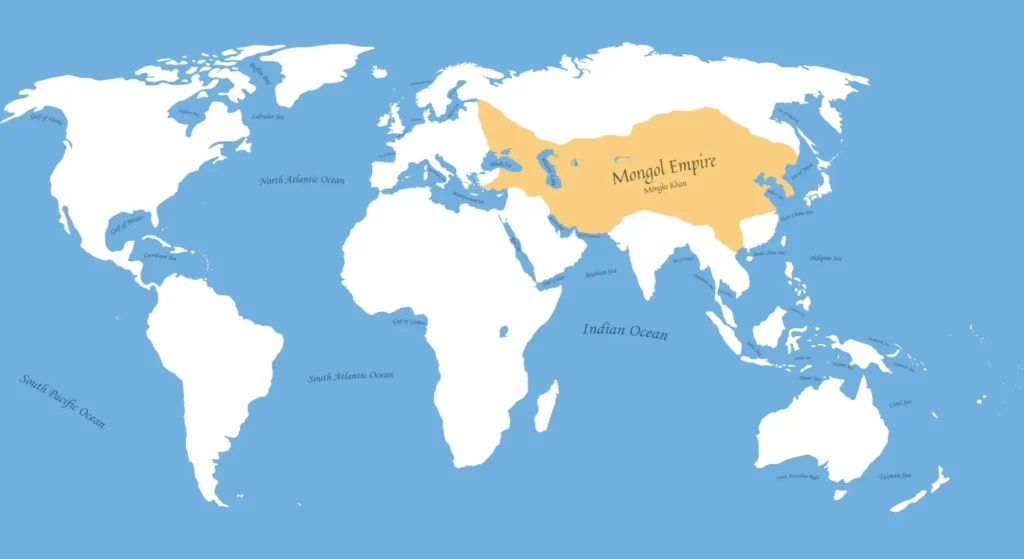The Mongol Empire
The Mongol Empire, founded by Genghis Khan in the early 13th century, was the largest contiguous land empire in history. Spanning from the steppes of Mongolia to Eastern Europe, the empire transformed Eurasia through military conquest, trade, cultural exchange, and administrative innovations. The Mongols are often remembered for their brutal tactics in warfare, but they also played a key role in shaping the medieval world, facilitating the Silk Road trade and influencing the political and cultural development of the regions they controlled.
The Rise of Genghis Khan
The Mongol Empire began with the unification of the Mongol tribes under the leadership of Temujin, who later took the title Genghis Khan (meaning “universal ruler”). Born around 1162 in the harsh environment of the Mongolian steppes, Genghis Khan grew up amid tribal conflict and warfare. Through a combination of diplomacy, military prowess, and strategic alliances, he united the Mongol clans by 1206, creating a centralized and powerful state.
- Key to His Success:
- Genghis Khan emphasized meritocracy, promoting individuals based on their skills rather than their family ties.
- He developed an efficient military structure, dividing his army into units of ten, one hundred, and one thousand soldiers, allowing for quick and coordinated movement.
- The Mongols were expert horsemen and archers, using these skills to create fast, flexible, and devastating military campaigns.
The Expansion of the Mongol Empire
Once Genghis Khan unified the Mongols, he set out to expand the empire. His conquests were swift and widespread, eventually creating an empire that stretched across much of Eurasia.
- China:
- In 1215, Genghis Khan began his conquest of the Jin Dynasty in northern China. His campaigns against the Chinese were brutal, but they also opened up the possibility for future Mongol rule over the entire region.
- By 1279, under Genghis Khan’s grandson, Kublai Khan, the Mongols had completed the conquest of China, founding the Yuan Dynasty.
- Central Asia and the Middle East:
- Genghis Khan also turned westward, launching campaigns against the Khwarazmian Empire in Central Asia. The Mongol invasion of this region, which included modern-day Iran, Afghanistan, and parts of Central Asia, was known for its ruthless efficiency.
- Following Genghis Khan’s death in 1227, his successors continued to expand the empire into the Middle East, conquering Baghdad and ending the Abbasid Caliphate in 1258.
- Russia and Eastern Europe:
- The Mongol Empire expanded into Russia and Eastern Europe under the leadership of Batu Khan, a grandson of Genghis Khan. The Mongols established the Golden Horde, a Mongol khanate that controlled much of Russia for over two centuries.
- Mongol forces also raided Poland, Hungary, and the Balkans, spreading their influence across Europe.
Governance and Administration
While the Mongol Empire is often associated with brutal military campaigns, its governance system was highly organized and innovative. Genghis Khan and his successors established a sophisticated administrative structure that allowed them to govern such a vast and diverse empire effectively.
- Law and Order:
- Genghis Khan implemented the Yassa, a legal code that promoted order, loyalty, and discipline within the empire. The Yassa emphasized harsh penalties for theft, betrayal, and corruption, ensuring stability and unity.
- Cultural Tolerance:
- Despite their fearsome reputation, the Mongols were relatively tolerant of different religions and cultures. They allowed conquered peoples to continue practicing their faiths and traditions as long as they paid tribute and did not rebel against Mongol rule.
- Trade and the Silk Road:
- The Mongol Empire revitalized the Silk Road, creating a secure environment for merchants, travelers, and diplomats to move across the empire. This facilitated the exchange of goods, ideas, and technologies between East and West, leading to a period of cultural and economic growth.
- The Mongols issued paiza or passports, which granted protection and rights to foreign merchants and diplomats traveling within the empire.
- Pax Mongolica:
- The term Pax Mongolica refers to the period of peace and stability across Eurasia under Mongol rule, which allowed for the safe passage of trade and the flourishing of cultural exchange. During this time, goods like silk, spices, and gunpowder traveled from China to Europe, while ideas such as Islamic astronomy and medical knowledge spread across Asia.
Legacy and Decline of the Mongol Empire
The Mongol Empire began to decline after the death of Kublai Khan in 1294, as internal divisions, succession struggles, and the sheer size of the empire made it difficult to govern. By the mid-14th century, the empire had fragmented into several smaller khanates, such as the Golden Horde, the Ilkhanate, and the Chagatai Khanate. These regions eventually fell to rising powers, including the Russian principalities, the Ottoman Empire, and the Ming Dynasty in China.
Despite its decline, the Mongol Empire left a lasting legacy:
- Cultural Exchange: The Mongol Empire fostered connections between the East and West, facilitating the exchange of ideas, goods, and technologies that shaped the world.
- Military Innovations: The Mongols introduced new military strategies and tactics, including the use of psychological warfare, mobility, and discipline, which influenced armies in subsequent centuries.
- Global Impact: The Mongol conquests reshaped the political map of Eurasia, leading to the rise of new states and powers. The empire’s influence can still be seen in the cultural and political development of many regions today.
